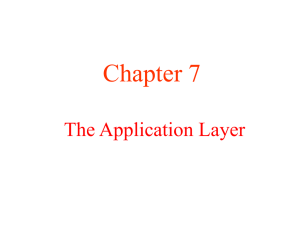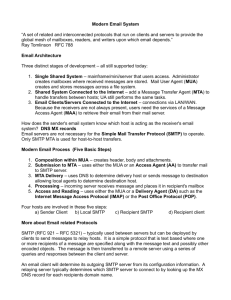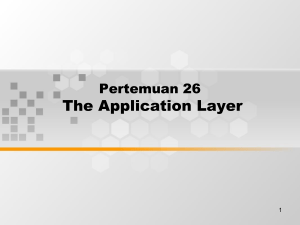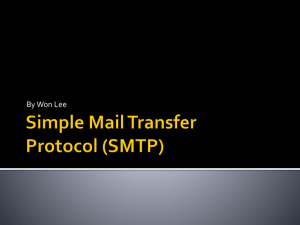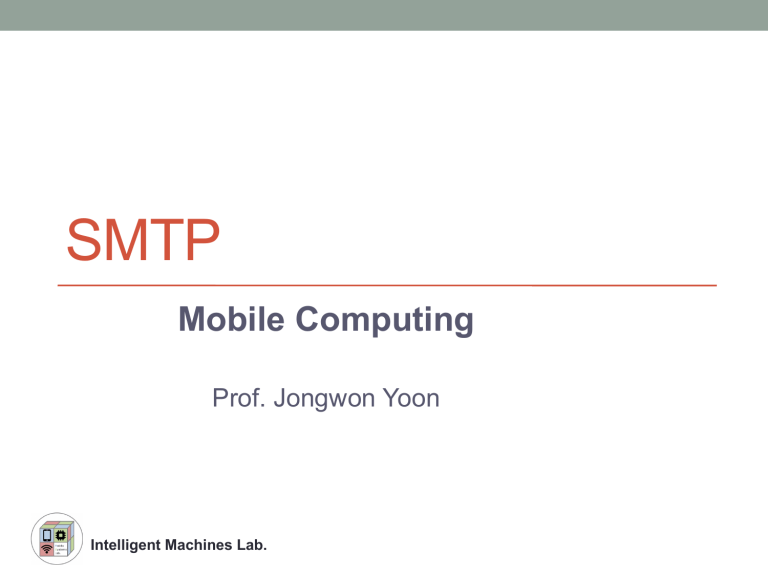
SMTP Mobile Computing Prof. Jongwon Yoon Intelligent Machines Lab. SMTP overview • SMTP clients and servers have two main components • User Agents (UA): Provides service to the user to make the process of preparing the message. • Mail Transfer Agent (MTA): Transfers the mail across the internet • Analogous to the postal system in many ways Message Transfer Agent • The actual mail transfer is done through message transfer agents (MTAs). • To send mail, a system must have the client MTA, and to receive mail, a system must have a server MTA. • The formal protocol that defines the MTA client and server in the Internet is called Simple Mail Transfer Protocol (SMTP). • Two pairs of MTA client-server programs are used in the most common situation. SMTP • SMTP also allows the use of Relays allowing other MTAs to relay the mail • Mail Gateways are used to relay mail prepared by a protocol other than SMTP and convert it to SMTP Format of an e-mail Command and response Connection establishment 220 service ready 2 1 HELO: deanza.edu 250 OK 3 Message transfer Connection termination 1 QUIT 221 service closed 2 Example Limitations in SMTP Only uses NVT (Network Virtual Terminal) 7 bit ASCII format (has limitations) • No authentication mechanisms • Messages are sent un-encrypted • Susceptible to misuse (Spamming, faking sender address) • Solution: MIME (SMTP extensions) • MIME – Multipurpose Internet Mail Extensions • MIME transforms non-ASCII data to NVT ASCII data and delivers it to the client MTA . • The message at the receiving site is transformed back to the original data. MIME Headers • Located between the Email Header and Body • MIME-Version: 1.1 • Content-Type: type/subtype • Content-Transfer-Encoding: encoding type • Content-Id: message id • Content-Description: textual explanation of non-textual contents MIME Headers • Content-Type – Type of data used in the Body • Text: plain, unformatted text; HTML • Multipart: Body contains different data types • Message: Body contains a whole, part, or pointer to a message • Image: Message contains a static image (JPEG, GIF) • Video: Message contains an animated image (MPEG) • Audio: Message contains a basic sound sample (8kHz) • Application: Message is of data type not previously defined • Content-Transfer-Encoding – How to encode the message • 7 bit – no encoding needed • 8 bit – Non-ASCII, short lines • Binary – Non-ASCII, unlimited length lines • Base64 – 6 bit blocks encoded into 8-bit ASCII • Quoted-printable – send non-ASCII characters as 3 ASCII characters, =##, ## is the hex representation of the byte Base64 Encoding Divides binary data into 24 bit blocks • Each block is then divided into 6 bit chunks • Each 6-bit section is interpreted as one character, 25% overhead • Quoted-Printable Encoding Used when the data has a small non-ASCII portion • Non-ASCII characters are sent as 3 characters • First is ‘=‘, second and third are the hex representation of the byte • Message Access Agent • The first and the second stages of mail delivery use SMTP. • SMTP is not involved in the third stage because SMTP is a push protocol. • The third stage needs a pull protocol; the client must pull messages from the server using a Message Access Agent (Mail Access Protocol, e.g., POP3, IMAP4). Post Office Protocol v3 • • • • • Simple Allows the user to obtain a list of their Emails Users can retrieve their emails Users can either delete or keep the email on their system Minimizes server resources POP3: Internet All Messages Whole messag e POP3 Internet Mail Access Protocol v4 • • • • • • Has more features than POP3 User can check the email header before downloading Emails can be accessed from any location Can search the email for a specific string of characters before downloading User can download parts of an email User can create, delete, or rename mailboxes on a server IMAP: Dr.Amer Friends …. Internet rs heade Web-based E-mail 1 HTTP transactions 2 3 4 Web-based E-mail HTTP transactions HTTP transactions 1 2 3
